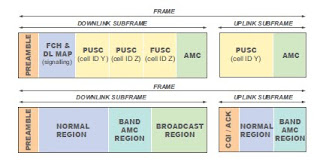OFDMA Sub-Channels and Permutation Zones
OFDMA Sub-Channels and Permutation Zones
- Sub-carriers may be adjacent or distributed in a sub-channel
- Sub-carriers are assigned to sub-channels to ensure frequency diversity and interference diversity.
Sub-channel Usage Schemes
- PUSC – Partial Usage of Sub-Channels
- Mandatory mode for sending preambles and allocation messages and all the uplink messages
- Sub-carriers are divided between cells (N=3) and then grouped into sub-channels
- Goal: Reduce RF interference
- FUSC - Full Usage of Sub-Channels
- Optional and used in the downlink only.
- All sub-carriers are available in every cell (N=1)
- Goal: Maximize throughput
- AMC – Adaptive Modulation and Coding
- Adjacent sub-carriers are grouped into sub-channels.
- Mobile devices provide feedback on channel conditions so the BS can adjust coding and modulation to match channel conditions.
In Mobile WiMAX, flexible sub-channel reuse is facilitated by sub-channel segmentation and
permutation zones. A Permutation Zone is a number of contiguous OFDMA symbols in the downlink
or uplink that use the same permutation or mapping sequence between the sub-channels and the
sub-carriers. A downlink frame may contain more than one permutation zone.
Zone Partitioning makes use of sub-carrier characteristics
- Normal region contains frequency diverse sub-channels. Time scheduling is used to support voice service.
- Band AMC region makes use of adjacent sub-channels and both time and frequency scheduling is available.
- Broadcast region uses frequency-diverse sub-channels in a simulcast mode. This concept is borrowed from DVB/DAB system.
- Preamble is a data-free symbol at the beginning of the frame for rough frequency synchronization in the receiver.



Comments